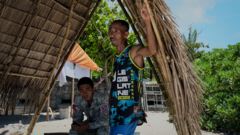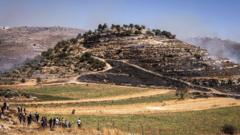Amid constant harassment from Chinese ships, the Filipino community on Pagasa Island holds steadfast to their way of life, bringing attention to the geopolitical tensions in the region.
Island of Resilience: Pagasa's Defiance Against Chinese Expansion in the South China Sea

Island of Resilience: Pagasa's Defiance Against Chinese Expansion in the South China Sea
As tensions rise in the South China Sea, the small island of Pagasa stands as a symbol of resistance against Chinese dominance.
Pagasa, a small island in the South China Sea governed by the Philippines, is becoming a beacon of resistance as it faces increasing pressures from Chinese maritime forces. Spanning just 37 hectares, it is home to approximately 300 residents who navigate a precarious existence in the shadow of a vast Chinese presence. While the island offers its inhabitants a tranquil lifestyle, its significance extends far beyond local fishing and farming—offshore, a multitude of Chinese navy, coastguard, and maritime militia vessels loom as a reminder of the contested waters.
For over a decade, China has escalated its control over the South China Sea, engaging in land reclamation and establishing military bases on submerged reefs. The growing tension has prompted only a few Southeast Asian nations, like Vietnam and the Philippines, to assert their claims amidst concerns over China's maritime ambitions. Pagasa Island, also known as Thitu, is unique due to its sizeable civilian population, solid land, and strategic importance in generating territorial waters under international law.
Jonathan Malaya, assistant director-general of the Philippines National Security Council, emphasizes Pagasa's critical role in asserting Philippine sovereignty. The island's infrastructure has seen significant upgrades in recent years, including a redeveloped runway and improved housing. However, the ongoing presence of Chinese vessels has severely impacted local fishermen, like Larry Hugo, who share their concerns regarding the imperious nature of the encroaching maritime forces.
Education and healthcare services have also evolved, catering to the growing youth population. Teacher Realyn Limbo encapsulated the community's sentiment, cherishing the island as a peaceful refuge amidst rising geopolitical tensions. Yet, families still rely on monthly government aid and deal with challenges resulting from both natural isolation and the effects of foreign infringements.
For the Filipino government, the situation in Pagasa represents not only a territorial claim but a testament to resilience. Diplomatic protests against China are now a weekly occurrence, marking a stark contrast to previous administrations that sought to downplay tensions in exchange for investment. The commitment to assert control reflects soaring nationalism amidst calls for sovereignty.
As the coastal waters continue to serve as a battleground for maritime supremacy, the residents of Pagasa navigate their existence with quiet defiance, embodying the struggle for autonomy in an intricate tapestry of international relations. While the island represents a disparate haven, its fate hangs in the balance as the geopolitical tug-of-war in the South China Sea unfolds.
For over a decade, China has escalated its control over the South China Sea, engaging in land reclamation and establishing military bases on submerged reefs. The growing tension has prompted only a few Southeast Asian nations, like Vietnam and the Philippines, to assert their claims amidst concerns over China's maritime ambitions. Pagasa Island, also known as Thitu, is unique due to its sizeable civilian population, solid land, and strategic importance in generating territorial waters under international law.
Jonathan Malaya, assistant director-general of the Philippines National Security Council, emphasizes Pagasa's critical role in asserting Philippine sovereignty. The island's infrastructure has seen significant upgrades in recent years, including a redeveloped runway and improved housing. However, the ongoing presence of Chinese vessels has severely impacted local fishermen, like Larry Hugo, who share their concerns regarding the imperious nature of the encroaching maritime forces.
Education and healthcare services have also evolved, catering to the growing youth population. Teacher Realyn Limbo encapsulated the community's sentiment, cherishing the island as a peaceful refuge amidst rising geopolitical tensions. Yet, families still rely on monthly government aid and deal with challenges resulting from both natural isolation and the effects of foreign infringements.
For the Filipino government, the situation in Pagasa represents not only a territorial claim but a testament to resilience. Diplomatic protests against China are now a weekly occurrence, marking a stark contrast to previous administrations that sought to downplay tensions in exchange for investment. The commitment to assert control reflects soaring nationalism amidst calls for sovereignty.
As the coastal waters continue to serve as a battleground for maritime supremacy, the residents of Pagasa navigate their existence with quiet defiance, embodying the struggle for autonomy in an intricate tapestry of international relations. While the island represents a disparate haven, its fate hangs in the balance as the geopolitical tug-of-war in the South China Sea unfolds.



















